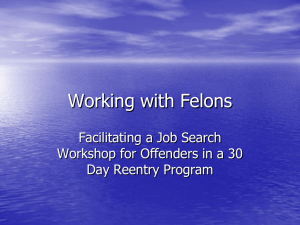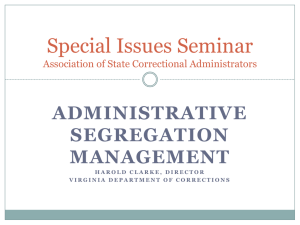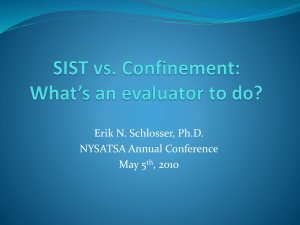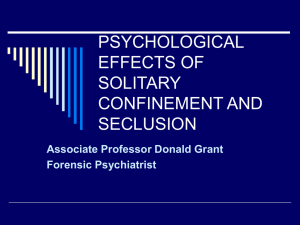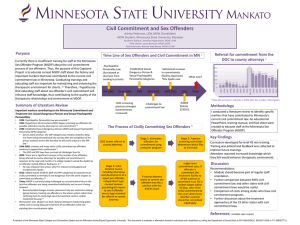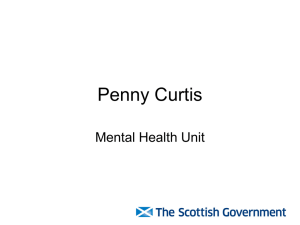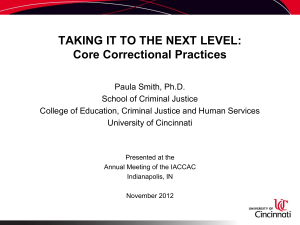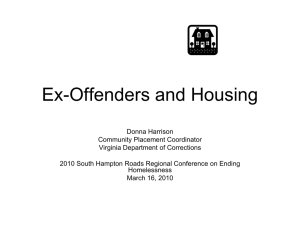Solitary Confinement - Academic and Health Policy Conference on
advertisement
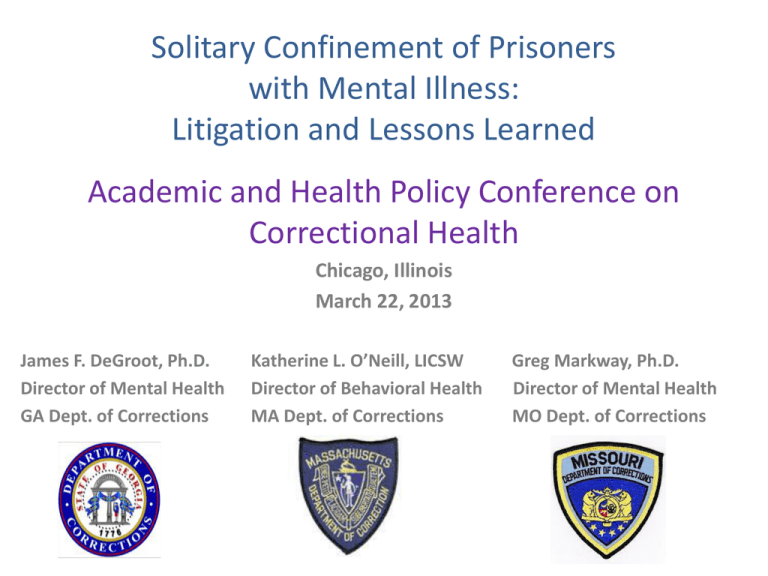
Solitary Confinement of Prisoners with Mental Illness: Litigation and Lessons Learned Academic and Health Policy Conference on Correctional Health Chicago, Illinois March 22, 2013 James F. DeGroot, Ph.D. Director of Mental Health GA Dept. of Corrections Katherine L. O’Neill, LICSW Director of Behavioral Health MA Dept. of Corrections Greg Markway, Ph.D. Director of Mental Health MO Dept. of Corrections Solitary Confinement of Prisoners with Mental Illness • Background Litigation (15 minutes) – James F. DeGroot, Ph.D. • Lessons Learned – Katherine L. O’Neill, LICSW, MA Dept. of Corrections (25 minutes) – Greg Markway, Ph.D., MO Dept. of Corrections (25 minutes) – James F. DeGroot, Ph.D., GA Dept. of Corrections (15 minutes) • Questions and Answers Solitary Confinement of Prisoners with Mental Illness Background Litigation • Basis of Litigation • Human Rights Framework • Scientific Research • Position Statements Solitary Confinement of Prisoners with Mental Illness Basis of Litigation • Eighth Amendment – Conditions of confinement (Deliberate Indifference) – Evolving Standards of Decency – Madrid v. Gomez (1995) • Class Action Litigation in 14 states (AL, AZ, CA, CN, FL, IN, MI, MS, NJ, NM, NY, OH, WI, TX) Solitary Confinement of Prisoners with Mental Illness Human Rights Framework • Principles – Respect the humanity and inherent dignity of all inmates – Prohibit torture or other cruel, inhumane or degrading punishment or treatment • International Covenant on Civil and Political Rights • Inter-American Commission on Human Rights Solitary Confinement of Prisoners with Mental Illness Scientific Research (What happens to people deprived of social contact for months or years?) • Challenges – – – – Definitions Samples Cress-sectional studies IRBs • Colorado State Penitentiary SuperMax Study – – – – Longitudinal Hypotheses Results Controversy Solitary Confinement of Prisoners with Mental Illness American Psychiatric Association (Approved by the Board of Trustees, 12/2012) (Approved by the Assembly, 11/2012): “Prolonged segregation of adult inmates with serious mental illness, with rare exceptions, should be avoided due to the potential for harm to such inmates. If an inmate with serious mental illness is placed in segregation, out-of-cell structured therapeutic activities (i.e., mental health/psychiatric treatment) in appropriate programming space and adequate unstructured out-of-cell time should be permitted. Correctional mental health authorities should work closely with administrative custody staff to maximize access to clinically indicated programming and recreation for these individuals.” Solitary Confinement of Prisoners with Mental Illness National Alliance on Mental Illness (11/2012): “Solitary confinement is the placement of individuals in locked, highly restrictive and isolated cells or similar areas of confinement for substantial periods of time with limited or no human contact and few, if any, rehabilitative services. Placement in solitary confinement frequently lasts for weeks, months, or even years at a time. It is extensively documented that solitary confinement is used disproportionately in correctional settings for juveniles and adults with severe psychiatric symptoms. In some states, it is reported that more than half of all inmates in facilities utilizing the most extreme forms of solitary confinement and social isolation are diagnosed with serious mental illnesses… NAMI opposes the use of solitary confinement and equivalent forms of administrative segregation for persons with mental illnesses. Solitary Confinement of Prisoners with Mental Illness National Alliance on Mental Illness (11/2012) cont.: “NAMI calls upon states to establish mental health alternatives to solitary confinement that include enhanced mental health treatment, services and programs; crisis intervention training for correctional officers, and mental health step-down units. States that have adopted such proactive efforts to eliminate solitary confinement have documented highly positive results that include reduced psychiatric symptoms, less violence, and significant cost savings.” Lessons Learned: The Massachusetts Department of Correction’s approach to treating and managing mentally ill offenders with long-term segregation sanctions Academic and Health Policy Conference on Correctional Health Chicago, Illinois March 22, 2013 KatherineL.L.O’Neill, O’Neill, LICSW Katherine LICSW Director of Behavioral Director of BehavioralHealth Health Massachusetts Department of Massachusetts Department ofCorrection Correction Time-line of litigation • 1/2006 -Records requested in conjunction with inmate suicide in segregation • 10/2006 –Investigation launched by Disability Law Center (DLC) into our Segregation Units • 1/2007 –Pre-litigation meetings with both sides took place to try and address concerns • 3/2007 – DLC filed suit against MA-DOC alleging that “confining prisoners with “serious mental illness” in segregation violates the 8th Amendment, ADA and Rehabilitation Act of 1973 • 4/2012 DLC and DOC achieve Settlement Agreement The Requests • DLC asked Court to prohibit DOC from confining inmates with mental illness from segregation for more than 1 week • DLC proposed a broad definition of SMI which would have required special treatment units for a large percentage of inmates • DLC toured facilities with their counsel and experts interviewing several inmates • DLC issued requests for extensive documentation from mental health records and administrative records. MA-DOC Response • Retained psychiatric expert (Jeffrey Metzner, M.D.,) for input • Developed and implemented initiatives stemming from expertise and experience of MHM (MH provider) & Dr. Metzner • DOC created “buy in” and executive leadership showed strong support for mental health input and reform • Worked with MHM to identify needs and to develop programs and protocols that made sense for our population MA-DOC initiatives • DOC implemented legal definition of “Serious Mental Illness” (SMI) – Trained all staff (custody, administration & clinical in applying definition) – Developed a system for identification and tracking inmates with SMI – Committed to excluding inmates with SMI designation from long-term segregation to include DDU. Massachusetts's SMI Definition MA-DOC Initiatives • DOC implemented MH Classification System – Individually based needs assessment tool – Identifies appropriate level of services – Service levels range from case management to inpatient hospitalization – Clearly identifies inmates with history of suicidal behavior, SMI designation, and inmates with high level of need for mental health services MA-DOC Initiatives • Developed specialized mental health units as placement alternatives to long-term segregation – Secure Treatment Program (February 2008) • 19 Beds, Maximum Security Prison – Behavior Management Unit (July 2010) • 10 Beds, Maximum Security Prison MA-DOC Initiatives • Complete revision of the 103 DOC 650 MH Policy and Procedures to memorialize all initiatives • DOC opened the Intensive Treatment Unit (ITU) in May 2012 – 32 Beds, Female Offenders – Designed to provide behavioral interventions and crisis stabilization • Inmates with shorter term segregation sanctions are provided enhanced services – Weekly out of cell clinical contact MA-DOC Initiatives • Complete enhancement of Residential Treatment Unit Program (RTU) – 4 RTUs across system, total of 208 beds – Designated mental health staff – Evidence based curriculums – Meaningful activities & socialization opportunities – Support for therapeutic communities MA-DOC Initiatives • DOC formalized process for MH input into disciplinary process • Developed specialized training for all staff working in specialized units • DOC enhanced Inmate Management System (IMS) – Improve communication across disciplines – Easily track performance data – Monitor trends and revise practices accordingly Applying the MH Classification System Massachusett’s Numbers *January 2013 Massachusett’s Numbers Massachusetts's Needs Developing our Alternative Units Why CQI should NOT be an afterthought Monitoring Performance Collecting Meaningful Data In the Headlines The Outcomes * As of January 2013 Sample Use of Force Incidents Staff Assaults Inpatient Hospitalization Days Inpatient Days (Averages) Disciplinary Infractions DDU Outcomes ITU Outcomes *May-December 2013 • 15% reduction in all self-injurious behaviors • 20% reduction in transfers to inpatient psychiatric hospitalization • 33% reduction in days on constant mental health watch • 46% decrease in total crisis contacts Truly a Team Effort! Special Thanks to the following: -The Commissioner’s Office -DOC Legal Division -DOC Health Services Division -Joel Andrade, Ph.D., LICSW & Dana Neitlich, LICSW -MHM Services, Inc. -Site Superintendents and DOC Administrations -University of Massachusetts Correctional Health -The clinical teams and unit coordinators for the STP, BMU, RTUs and ITU. An Innovative Approach to Solitary Confinement The Potosi Reintegration Unit (PRU) Potosi Correctional Center Missouri Department of Corrections Presented by Greg Markway, Ph.D. Background • Potosi Correctional Center is the most secure facility in Missouri • Very limited movement in the camp • PCC houses offenders sentenced to death • Historically, has housed most difficult offenders—the “Hannibal Lecters” of MO Background (2) PCC had a small Ad Seg unit that housed offenders with serious Protective Custody needs, as well as offenders who had seriously assaulted or killed other offenders or staff How do you decide when an offender is ready/able to return to general population? What makes this offender safer today than last week? Background (3) • HU-1 was a small Ad Seg Unit, housing approximately 21 offenders • The unit was no longer economically feasible unless it took on a new mission • Through the creativity of our custody division, and the cooperation mental health, a new mission was developed. Mission of PRU Take some of the most difficult to manage offenders, those in long-term single cell ad seg, and provide programming with the goal of returning them to general population if possible Be able to answer why they can be returned to GP, or why they need to stay in Ad Seg Develop collaborative programming with mental health, custody, and classification Initial Obstacles • Resistance of custody staff— “How far down has corrections gone?” • Perception of coddling offenders who have been “the worst of the worst” Seeds of Change • Warden approached staff with new mission (Staff Buy-In) • Developed Oversight Committee—Unit Manager, Deputy Warden, Classification, Mental Health, and Medical Staff (Broad Input) • Any committee member allowed to veto a recommendation (all staff on committee equal in input and responsibility) Program Development Cleared an office to be used as small classroom/group room (camera, panic buttons) Special desks designed (allowed offenders to be in room together while still restrained—but also allow movement) Offenders assessed fresh (WAIS, MMPI, etc.) Programming brought into unit (MH, volunteers, chaplain, classification staff) Uneasy First Steps • Offenders brought into class for programming • Little progress initially—offenders struggling— “Would just sit there in a fetal ball emotionally” • No interaction Signs of Progress • Psychologist noted one offender liked to draw, so she took an art therapy approach • Art supplies were allowed on the unit • Offender drew a picture in group, and others began commenting on it—the ice was broken Next Steps • 3 months into the program, staff began discussing incentives for offenders—needed to be personalized and realistic • Began with things the offenders had shown they liked to do • Led to development of true individualized behavior plans • Offenders did not trust this– “Had to throw them a bone” Incentive Program • Once program began, officers stated: “We’ve never seen these guys act like this before.” Incentive Examples Listen to books on CD with portable CD player in cell for set time Keep book or magazine in cell Work on jigsaw puzzle Rec time outside cell with another offender Purchase a CD player with own funds Have access to art materials Eat lunch outdoors with another offender Other activities • TV time/movie discussion group—Groundhog Day example • GED classes • Other programming with inmate facilitators • Dogs Behavior Change Examples • Offender with poor reading skills requested book to go along with CD—working on his own reading skills • Offender who frequently swallows objects now is able to wear his eyeglasses and keep Bible in cell • Some offenders are helping others learn to read, complete homework, etc Staff Behavior Changes • “We became like parents looking at our kids’ pictures. People developed an interest in the offender as a person.” • Oversight Committee truly became interdisciplinary • Interestingly, now mental health has to slow custody down in granting privileges • Custody officers advocate for offenders Results • Dramatic reduction in uses of force in the unit • Officers now raise questions about medication/mental health/medical issues • Officers see offenders as people • Officers are proud of their accomplishments with the offenders • “Administration treated us like human beings” Georgia Lessons Learned The Georgia Department of Corrections’ Approach to Reducing Mentally Ill Offenders in Solitary Confinement James F. DeGroot, Ph.D. Director of Mental Health Georgia Department of Corrections Georgia Lessons Learned • Time-line of Litigation – 1972 – 1998 Guthrie v. Evans – 1984 – 1998 Cason v. Seckinger – 2002 – 2004 Fluellen v. Wetherington Georgia Lessons Learned • Eighth Amendment Complaints • External Audit Results (2008): Mentally ill offenders were disproportionally represented in lock-down units. Georgia Lessons Learned Data 2008 % of offenders receiving MH services 32% % of all DRs received by MH offenders 41% % of MH and GP receiving sanctions MH=88%/GP=47% % of MH and GP placed in disciplinary segregation MH=56%/GP=21% % of all offenders in disciplinary segregation receiving MH services % of MH and GP serving more than 2 weeks in disciplinary segregation 63% MH=43%/GP=30% Georgia Lessons Learned • Procedures already in place: – – – – – – – – – – DR Evaluations (mitigating circumstances) Alternative sanctions Weekly lockdown treatment sessions Weekly lockdown rounds Activity Therapy Individualized Behavior Therapeutic Unit Isolation/Segregation Health Screening Out-of-cell mental health services Out-of-cell structured/unstructured activities Mental Health input into disciplinary process Georgia Lessons Learned • New Procedures – Publish monthly oversight results – Upper level management support Georgia Lessons Learned • Six months after publishing oversight Data Original 6 Months Later Males Females % on Mental Health 32% 32% 51% % of all DRs to Mental Health 41% 43% 65% % of MH and GP Sanctions MH = 88% GP = 74% MH = 78% GP = 84% MH = 50% GP = 59% % MH and GP in Disciplinary Seg MH = 56% GP = 21% MH = 18% GP = 14% MH = 19% GP = 16% % of all offenders in Disciplinary Seg MH = 63% GP = 37% MH = 33% GP = 67% MH = 67% GP = 33% % of MH and GP serving more than MH = 43% 2 weeks in disciplinary seg GP = 30% MH = 14% GP = 27% MH = 4% GP = 14% Georgia Lessons Learned • Data – % of males receiving MH services system-wide 14% – % of MH in High-Maximum Security 46% • Corrective Action – High-Maximum Security Supportive Living Unit – Therapeutic Modules Georgia Lessons Learned Therapeutic Mental Health Modules at Augusta State Medical Prison Georgia Lessons Learned • Data – % of all self-injurious behavior in lockdown 60% – % of all suicides in lockdown 63% Georgia Lessons Learned • What works in reducing mentally ill offenders in solitary confinement? – Upper Level Management Support – Mental Health Standards of Care – Monthly Data Reports – Publish the results Questions?
